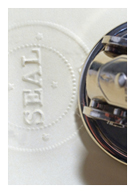Notary Stamp and Seal Issues
| The Traditional Notary Seal Embosser ASN Hot Tip, Published January 2010-#1 |
|
While convenience and the need for a reproducible image have made ink-stamps the predominant tool used by today’s notaries, the embosser is still authorized for use as an official notary seal in 30 states (includes the U.S. Virgin Islands). The embosser is the only authorized tool in two of those jurisdictions (District of Columbia, and the U>S. Virgin Islands). Elsewhere, many notaries elect to use an embosser in conjunction with their official notary stamp for the additional ceremonial impact that the raised seal impression achieves, and to help assure acceptance of notarized documents in other countries and jurisdictions. On these points, the late John E. “Jack” Seth, ASN Director Emeritus, attorney and notary expert, wrote:
Whether it’s the required notary seal imprinting tool or whether you use one by choice, the embosser is a special tool that requires thoughtful use and handling. Keep these tips in mind:
Questions, comments on this Hot Tip? Email support@asnnotary.org |
| Photographically Reproducible Seal Impressions Published ASN Hot Tip 2008 |
|
The Situation: A somewhat irate client came into a notary’s office with a document over which the notary had performed a notarial act a week ago. The client told the notary that the document was rejected by the document recipient because they had to make photocopies of the document that showed the notary’s official seal. The Notary's Dilemma: The notary's state authorizes notaries to use a metal embosser as an official seal. The raised embossment that the notary made on the notarial certificate of this document did not show up as part of a photocopy of the document. More and more states are requiring that the notary’s official seal on a notarial certificate be photographically reproducible. When a notary uses an ink stamp as her official seal, it is usually in black ink and will show up on a photocopy of the document. (Utah requires purple ink and Tennessee requires a color other than black or yellow.) Metal embossers that leave a raised imprint on the notarial certificate are permitted for use as an official seal by some states. However, the raised imprint by itself will not show up on a photocopy of the document. The Solution: If a notary uses a metal embosser as her official seal, she should carefully darken the very top of the raised embossment so that the seal will be visible on a photocopy of the document. Fortunately, there is the seal impression inker. It is a round ink pad with a tab on the back. The notary holds the impression inker by the tab and gently lowers it onto the raised embossment. A slight turn of the pad inks the top of the raised impression. Even if your state has no particular regulation on notary seals being photographically reproducible, be aware that once it leaves you, the document bearing your notarial certificate could be subject to many circumstances requiring it to be photocopied. ASN recommends, therefore, that if you use an embosser as your official notarial seal, you should also make it a habit to darken the raised seal embossment with a seal impression inker. Questions, comments on this Hot Tip? Email support@asnnotary.org |
| Properly Dispose of Your Notary Seal from Your Previous Notary Commission ASN Hot Tip, February 2009-#2 |
|
The Situation: ASN is frequently called or emailed by notaries whose commission has expired, and they now have a notary stamp and/or embosser that they can’t legally use any longer. The Notary’s Dilemma: What should a notary do with an official notary commission stamp and/or notary seal embosser from an expired notary public commission? The Solution: Some states have specific steps for the notary to take, including submitting the seal to state notary authorities upon commission expiration or resignation/revocation or death. So, in any case where you cease to be a notary, you need to learn whether your state has a specific requirement for you to deliver your seal to your state’s notary authorities. ASN can help you determine if your state has such a requirement. If your state has no specific instructions for disposition of your seal when you cease to be a notary, you must be sure to deface your seal to ensure it can never be used again. In cases where the only course to take is actual destruction of the seal, do you know how to do it effectively? The Process: The old seal must be defaced in a way that makes it impossible for the seal to make enough of an impression on a notarial certificate to authenticate it. More to the point, the portion of the seal that leaves an ink impression or embossment must be destroyed. (We know of a notary who smashed his self-inking stamp case to smithereens with a hammer, but left intact the rubber pad that was used to make the seal impression.) HOW TO DESTROY Distribute the pieces of the pad into at least two different trash containers. Destroying a metal embossing seal is a little more involved. One way is to remove the die insert from the embosser handle and carefully deface the raised portion of the seal impression with a heavy-duty steel file. This works especially well if you break the die insert into two pieces. Discard each die insert piece into separate trash containers. Another method is to contact your local law enforcement agency, and ask if you may turn in the embosser’s die insert to be melted down with confiscated firearms. (We include this because we actually spoke with one local law enforcement agency that was happy to accept die inserts for melting.) We get many good ideas from our members, so let us know if you have found a safe way to destroy an old seal that we haven’t listed here. Questions, comments on this Hot Tip? Email support@asnnotary.org |
| Bogus Notary Stamp Used in Empire State Building "Theft" Published American Notary, Issue 2008-#4 |
|
The deal was done upon recordation of a bogus deed to transfer the iconic building from its rightful owners to “Nelots Properties, LLC,” a fake company set up by the Daily News. Clerks in the city register’s office did not verify certain information on the fake deed, a common occurrence the paper calls a “gaping loophole” that makes property theft easy and common in the Big Apple. Closer inspection of the fake documents would have revealed such scam tipoffs as the late Fay Wray (of King Kong fame) being listed as a witness; infamous bank robber Willie Sutton as the notary; and that the company name “Nelots” was derived from the word “stolen,” spelled backward. The fake documents included a notary seal impression belonging to “Notary” Willie Sutton. The Daily News singles out bogus notary seals as a “major tool” in such scams, a distressing conclusion supported by the fact that it’s easy to buy a notary commission stamp from any of the numerous vendors who don’t require evidence of the notary’s active commission status. ASN takes every opportunity to educate businesses and notaries about the importance of obtaining commission stamps only from responsible vendors who not only require evidence of commission status, but who also actively maintain up-to-date information on stamp/seal requirements. The Daily News has been investigating the issue of mortgage fraud and asserts that mortgage brokers, title company representatives, lenders, attorneys and others connected with processing mortgage loan transactions often fail to verify identification and other information provided by thieves. Having proven its point by succeeding in its forged deed caper, “Nelots Properties, LLC” (the newspaper) promptly returned the Empire State Building to its rightful owners. City prosecutors are calling for an overhaul of how the city register’s office handles the paperwork associated with a property transaction (you think?!). Questions, comments on this Hot Tip? Email support@asnnotary.org |
| Where is Your Notary Seal? ASN Hot Tip, November 2008-#2 |
|
Can you put your hand on your notary seal at this moment? Do you know exactly where it is? Is it safely locked away where no one but you can get to it? You are responsible for the security of your official notary seal, your recordbook, your notary commission certificate and any other documents relating to your work as a notary public. What if your notary seal is lost or stolen and falls into the hands of the “wrong person”? Your notary seal can then be used to perpetrate fraud on unsuspecting individuals in your name. EXAMPLE The experience, unfortunately, gave the perpetrator the idea that getting her hands on a notary public commission seal could solve her problem. That is, she could skirt the need for a notary if she could find a way to impersonate both the notary and the document signer. With a notary’s commission seal in hand, the perpetrator would be free to forge another person’s signature on the document and to forge the notarial certificate. This criminal went to several different notaries public, asking for performance of a notarial act. She soon found one who, at some point during the notarial act, had to leave his desk for just a moment to see to another aspect of his job. The notary left the criminal unobserved and his notary seal on his desk—a big mistake. When he returned, the “client” and his notary seal were both gone. Though he was upset, the notary had the presence of mind to immediately notify the Notary Public Administrator's Office that his seal had been stolen. OUTCOME Had this notary sufficiently safeguarded his notary seal? Evidently not, since it was very easily stolen. To adequately protect your seal from unauthorized use, you MUST either have it in your possession or in a locked drawer that only you can access. The notary in the above example could have taken a few seconds to lock his notary seal in his desk drawer instead of leaving it unattended on his desk. A bank teller would never walk away from her cash drawer without locking it. The notary’s stolen seal in the above story was worth over $20,000 cash to the perpetrator of this particular fraud. Secure your notary seal as if it were a large amount of cash. Don’t ever let your notary seal fall into the hands of the “wrong person”! Questions, comments on this Hot Tip? Email support@asnnotary.org |
| The Notary’s Signature and Seal ASN Hot Tip, January 2008-#1 |
| What is the significance of the notary signing the notarial certificate and placing her official seal near her signature? The notarial certificate is a record of the elements of the immediately preceding notarial act. It is called a notarial certificate because the notary certifies that everything stated in the wording of the certificate actually took place. A completed notarial certificate conveys to others that a trained and impartial officer of the state--the notary—personally ensured that the actions necessary to execute the document were performed properly, with the true document signer present as a willing and knowing party to the transaction. The involvement of a notary creates an invaluable level of trust in the integrity of a document execution. It is vital that the notarial certificate be filled out completely and truthfully. The Notarial Certificate In the body of the notarial certificate, the notary certifies that the client was in the physical presence of the notary during the performance of the notarial act. This presence is indicated by words such as “personally appeared” or “before me.” The notary certifies as a state officer that she gave an oath/affirmation to the signer or took the signer’s acknowledgment in a verbal ceremony. This means that the notary asked the document signer aloud if the information in the document is true (oath/affirmation), or she asked the document signer aloud if the signature on the document is his, if he understands the contents of the document and if he is signing the document without being coerced (acknowledgment). The notary also heard the signer’s verbal and affirmative reply to the notary’s verbal ceremony. Also in the certificate, the notary certifies the date on which the notarial act occurred. No date except the date of the notarial act may be put in that space on the notarial certificate. The notary certifies the name(s) of the signer(s) who were physically present during the performance of the notarial act. Of course, to put any signer’s (or signers’) name on the certificate other than the signer who actually appeared constitutes creating a false notarial certificate. The notary also certifies the method by which she positively identified the signer. If identification was made from an ID card, do not write the full number of the ID card on the notarial certificate; at most, record a fragment of the full number. The notarial certificate may be seen by a number of people or even be part of a document that is publicly recorded. The notary should protect the signer from becoming a victim of identity theft. Remember that the notarial certificate is not the notarial act, itself. It is a record of the process of performing the notarial act. If the notary signs the notarial certificate with her official signature as a notary and affixes her official seal on the certificate, she is certifying that all the steps of a proper notarial act were carried out, including positively identifying the signer, ensuring the document is physically eligible for notarization (proper date, no missing pages, etc.) and administering the appropriate verbal ceremony. If the verbal ceremony did not take place, then the notary has created a false notarial certificate. It is specifically against the law in most states for the notary to sign and seal a notarial certificate that she knows to be false. A truthfully completed notarial certificate, signed and sealed by the notary, is the culmination of a procedure designed to bring a level of certainty and trust to document transactions. Always complete your notarial certificate meticulously and truthfully! |
|
Questions, comments on this Hot Tip? Email support@asnnotary.org |
 Your data is safe with us! (read our privacy and security policy)
Your data is safe with us! (read our privacy and security policy)


 For traditionalists, nothing conveys the authority and beauty of an official notarial
For traditionalists, nothing conveys the authority and beauty of an official notarial  In a stunt that relied on chutzpah, bogus documents and a fake notary stamp, the New York Daily News made news recently by “stealing” the $2 billion Empire State Building.
In a stunt that relied on chutzpah, bogus documents and a fake notary stamp, the New York Daily News made news recently by “stealing” the $2 billion Empire State Building.